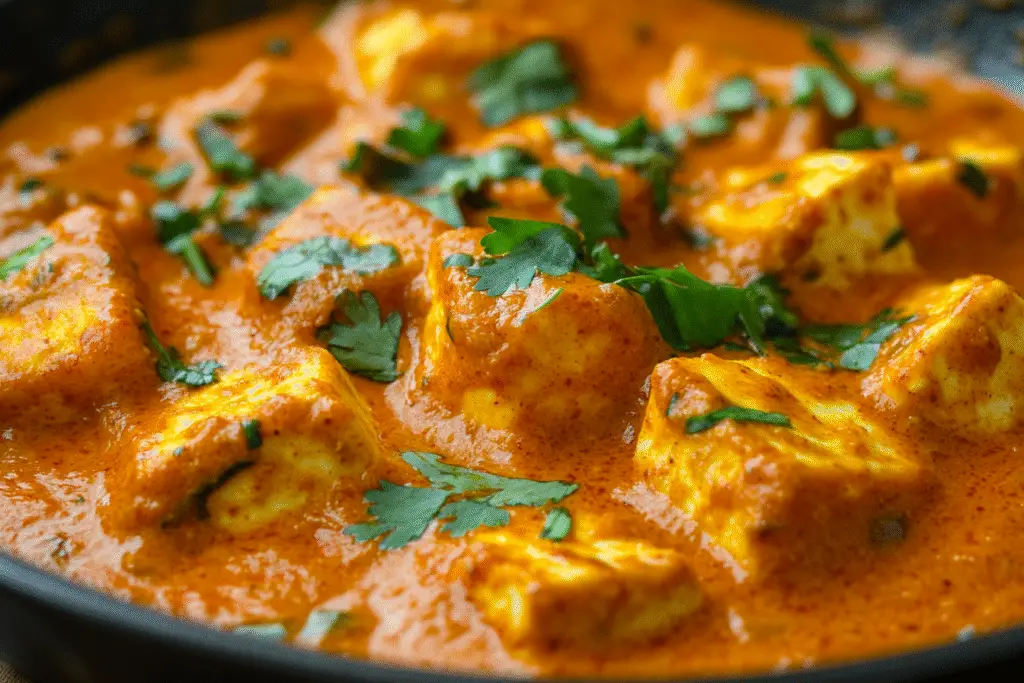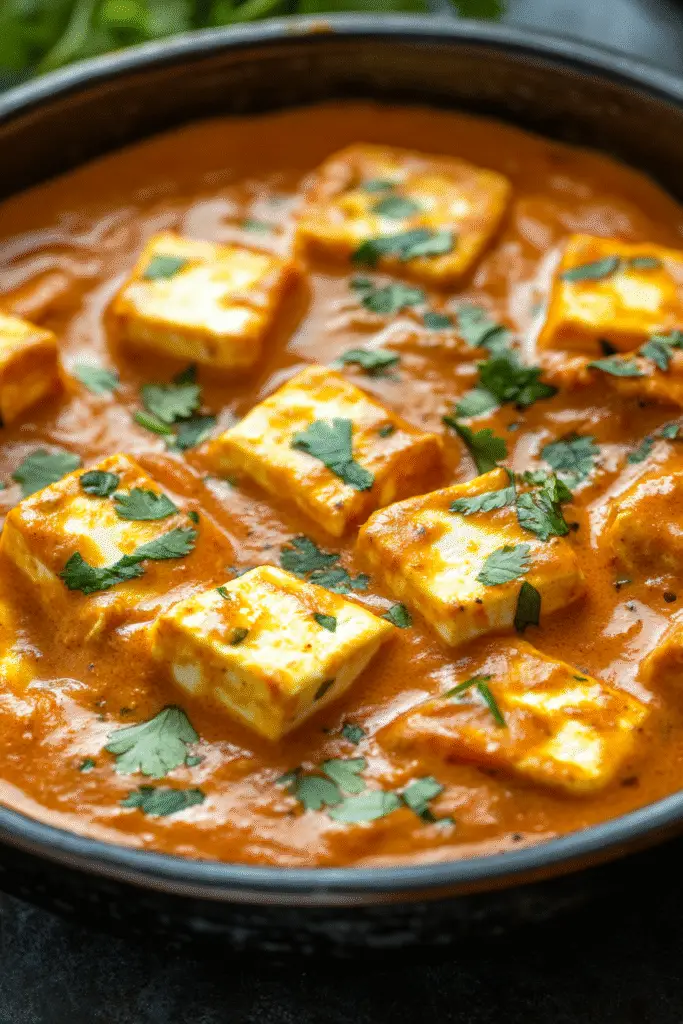The Universal Appeal of Paneer Curry
Paneer Curry is a beloved staple of Indian cuisine, known for its soft, delicate cubes of paneer cheese simmered in a richly spiced, creamy tomato-based sauce. Whether you’re dining in a traditional Indian home or ordering from a favorite takeaway, paneer curry is a dish that offers comfort, balance, and a beautiful interplay of spices without overwhelming heat.
Paneer, a fresh, non-melting cheese, soaks up the flavors of the curry while holding its shape, giving each bite a perfect contrast of tender creaminess and bold, savory sauce. What sets paneer curry apart is its versatility—it can lean toward the creamy, buttery style of paneer makhani, the hearty depth of paneer tikka masala, or the homestyle simplicity of a tomato-onion gravy.
This particular recipe focuses on a restaurant-style paneer curry that’s rich but easy to make, using accessible ingredients and a straightforward process. It’s perfect for vegetarians, endlessly customizable, and pairs beautifully with a variety of breads and rice.
Selecting the Best Paneer
Fresh Paneer:
- Homemade: Fresh paneer made with milk and lemon juice gives the softest texture and best flavor.
- Store-Bought: Works perfectly if fresh paneer isn’t available. Look for firm blocks that can be cubed easily.
Frying Paneer:
- Optional Step: Lightly frying paneer cubes in oil or ghee gives them a golden crust and a slight chew but is not essential. Leaving them soft allows them to absorb more sauce.
Frozen Paneer:
- Readily available in most supermarkets. Thaw and soak in warm water for 10–15 minutes to refresh the texture before cooking.

Recommended Equipment for the Best Results
- Heavy-Bottomed Pan: Ensures even cooking and prevents burning when simmering the tomato-based sauce.
- Blender or Immersion Blender: Optional, but creates a silky smooth curry base.
- Sharp Knife: For cleanly cubing paneer.
- Wooden Spoon: To stir gently without breaking the soft paneer cubes.
Common Mistakes and How to Avoid Them
1. Overcooking Paneer
Paneer only needs to be warmed through in the sauce. Overcooking can make it rubbery.
2. Skipping the Blending Step
Blending the sauce creates the velvety texture found in restaurant curries. If you prefer a homestyle, chunkier sauce, you can skip this step.
3. Adding Cream Too Early
Heavy cream should be stirred in at the end to prevent curdling and preserve its rich, smooth texture.
Ingredient Swaps and Dietary Adjustments
- Vegan Option: Replace paneer with firm tofu and use coconut milk or cashew cream instead of dairy cream.
- Nut-Free: Skip cashew paste if using and rely on cream alone to thicken the sauce.
- Low-Fat Version: Use milk instead of cream and reduce ghee or butter amounts.
Prep-Ahead and Time-Saving Tips
- Pre-Cube Paneer: Store in the fridge, covered, for up to 2 days.
- Make Sauce in Advance: Curry base can be prepared up to 3 days ahead and refrigerated, or frozen for up to 1 month.
- Use Pre-Made Garam Masala: Reduces the need for individual spice measuring and speeds up the cooking process.

Flavor Boosters and Pairing Ideas
- Garnish with Kasuri Methi (Dried Fenugreek Leaves): Adds the signature restaurant-style aroma and slight bitterness that balances the rich sauce.
- Add a Pinch of Sugar: To round out acidity from tomatoes and highlight the sweetness of cream.
- Finish with Fresh Coriander: Adds a bright, herbal note.
Pair With:
- Soft naan, chapatis, or paratha.
- Steamed basmati rice or jeera rice.
- Cooling cucumber raita or kachumber salad to balance the warm spices.
Paneer Curry Recipe
Ingredients
- 250 g (9 oz) paneer, cubed
- 2 tablespoons oil or ghee
- 1 teaspoon cumin seeds
- 1 large onion, finely chopped
- 4 garlic cloves, minced
- 1 tablespoon fresh ginger, grated
- 2 large tomatoes, pureed (or 1 cup canned crushed tomatoes)
- 1 tablespoon tomato paste
- 1 teaspoon ground coriander
- 1 teaspoon ground cumin
- 1/2 teaspoon turmeric powder
- 1 teaspoon garam masala (plus extra for garnish)
- 1/2 teaspoon chili powder (adjust to taste)
- 1/2 cup water (or as needed for desired sauce consistency)
- 1/4 cup heavy cream (or coconut cream for vegan)
- Salt, to taste
- Fresh cilantro, for garnish
- Optional: 1 teaspoon kasuri methi (dried fenugreek leaves)
- Optional: 1 teaspoon sugar to balance acidity
Instructions
Step 1: Sauté Aromatics
- Heat oil or ghee in a heavy-bottomed pan over medium heat.
- Add cumin seeds and let them sizzle for 30 seconds until fragrant.
- Stir in chopped onions and sauté for 8–10 minutes until golden brown.
Step 2: Build the Sauce
- Add minced garlic and ginger. Cook for 1–2 minutes until fragrant.
- Stir in pureed tomatoes, tomato paste, ground coriander, cumin, turmeric, garam masala, and chili powder.
- Cook for 10–12 minutes, stirring frequently, until the sauce thickens and the oil begins to separate.
Step 3: Blend (Optional)
- For a smooth sauce, use an immersion blender or transfer the mixture to a blender and blend until silky. Return to the pan.
Step 4: Simmer and Season
- Add water to adjust the sauce to your preferred thickness.
- Stir in sugar (if using) and kasuri methi (if available) for extra flavor.
- Simmer for another 3–5 minutes to meld flavors.
Step 5: Add Paneer and Cream
- Gently add paneer cubes and simmer for 3–5 minutes until heated through.
- Stir in cream and season with salt to taste.
- Simmer for an additional minute, then remove from heat.
Step 6: Garnish and Serve
- Garnish with fresh cilantro and an extra sprinkle of garam masala.
- Serve hot with naan, chapatis, or steamed basmati rice.
Storage and Reheating
- Refrigerator: Store in an airtight container for up to 3 days.
- Freezing: The sauce can be frozen without paneer for up to 1 month. Add fresh paneer when reheating.
- Reheating: Warm gently on the stovetop, adding a splash of water or cream if needed to loosen the sauce.
Troubleshooting Tips
- Sauce Too Thin? Simmer uncovered to reduce or add a spoonful of blended cashew paste.
- Sauce Too Thick? Add a little water or cream to adjust.
- Paneer Tough? It may be overcooked—add paneer at the end and simmer briefly just to heat through.
Variations: Paneer Curry Styles
- Paneer Makhani: Creamy, butter-rich, and slightly sweet with a smooth tomato base.
- Paneer Tikka Masala: Grilled paneer pieces in a spiced, creamy sauce.
- Homestyle Paneer Curry: Chunkier onions and tomatoes with a more rustic texture and lighter gravy.
Each version offers unique textures and spice balances but all showcase the tender, flavorful paneer at their heart.
Serving Suggestions
- With Breads: Serve with warm naan, chapatis, or parathas to scoop up the sauce.
- With Rice: Pair with basmati or jeera (cumin) rice for a satisfying meal.
- As Part of a Spread: Include dal, samosas, raita, and pickles for a complete Indian feast.
- With Cooling Sides: Cucumber raita, fresh tomato-onion salad, or mango chutney to balance the spices.
Paneer curry pairs beautifully with lassi, sparkling water with lemon, or a crisp white wine like Sauvignon Blanc to balance the rich, creamy sauce.
